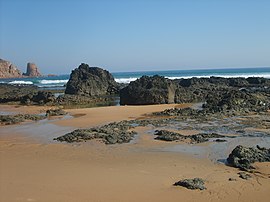Not to be confused with Woolamai, Victoria.Suburb of Bass Coast Shire, Victoria, Australia
| Cape Woolamai Victoria | |||||||||||||||
|---|---|---|---|---|---|---|---|---|---|---|---|---|---|---|---|
 The rocks and rockpools at Cape Woolamai Surf Beach The rocks and rockpools at Cape Woolamai Surf Beach | |||||||||||||||
 | |||||||||||||||
| Coordinates | 38°31′40″S 145°20′13″E / 38.52778°S 145.33694°E / -38.52778; 145.33694 | ||||||||||||||
| Population | 2,301 (2021 census) | ||||||||||||||
| Established | 1959 | ||||||||||||||
| Postcode(s) | 3925 | ||||||||||||||
| Location | 140 km (87 mi) from Melbourne | ||||||||||||||
| LGA(s) | Bass Coast Shire | ||||||||||||||
| State electorate(s) | Bass | ||||||||||||||
| Federal division(s) | Monash | ||||||||||||||
| |||||||||||||||
Cape Woolamai is a town and headland at the south eastern tip of Phillip Island in Victoria, Australia. It is home to Cape Woolamai State Faunal Reserve and the Phillip Island Airport. Cape Woolamai contains a subdivision also called Cape Woolamai (formerly known as Woolamai Waters and Woolamai Waters West).
History
The cape was named by George Bass (but spelt "Wollamai") when he passed it on his whaleboat voyage in early 1798. Wollamai is the snapper fish (Pagrus auratus) in the language of the Eora Aboriginal people of Port Jackson, where the fish is found. Bass, who had learnt some of the Sydney language from the Eora leader Bennelong, thought the headland resembled the head of that fish.
In 1826, during the establishment of Fort Dumaresq, near Rhyll, coal was reported to have been found in the vicinity of the Cape.
The area was purchased from the government in 1868 by John Cleeland, sea captain, publican and owner of the Melbourne Cup winner of 1875. He then built Wollomai House and ran merino sheep from New South Wales. In 1910 his son, John Blake Cleeland, noticed the sand was shifting due to erosion, so he planted rows of Marram grass, still evident today.
In 1959, 93 hectares (230 acres) of farmland was sold and subdivided into housing estates for beach shacks and holiday makers. It was then named Woolamai Waters and Woolamai Waters West, and later renamed Cape Woolamai. Cape Woolamai had a Post Office from 1970 to roughly 1974 which was open only during summer. A Woolamai Post Office was open from 1911 until 1974. The roads were sealed in the late 1980s and beach shacks gradually turned into more substantial houses. Today Cape Woolamai has a world-renowned surf beach, Woolamai Beach Surf Life Saving Club, and a popular Safety Beach.
Environment
The headland contains remnant vegetation and wildlife such as an important breeding colony of the short-tailed shearwater, also called the Australian muttonbird. Volunteer groups such as the Cape Woolamai Coast Action Group conduct regular improvement and maintenance works including weed control and revegetation. It lies within the Phillip Island Important Bird Area, identified as such by BirdLife International because of its importance in supporting significant populations of little penguins, short-tailed shearwaters and Pacific gulls.
Gallery
-
 View from the cape looking toward San Remo/Kilcunda coast
View from the cape looking toward San Remo/Kilcunda coast
-
 View from the cape looking south
View from the cape looking south
-

-

-

-

-

-
The surf club at Cape Woolamai
-
The gazebo on The Esplanade
-
A nice, sunny day at Cape Woolamai Surf Beach
References
- Australian Bureau of Statistics (28 June 2022). "Cape Woolamai (State Suburb)". 2021 Census QuickStats. Retrieved 1 October 2007.

-
- A Voyage to Terra Australis by Matthew Flinders, volume 1 at Project Gutenberg, his entry for 3 May 1802
- "The Life of Captain Matthew Flinders R.N." gutenberg.net.au. Retrieved 17 December 2023.
- Australian Aboriginal words in English, R. M. W. Dixon, Oxford University Press, 1990, ISBN 0-19-553099-3
- Miriam Estensen, The Life of George Bass, Allen and Unwin, 2005, ISBN 1-74114-130-3
- "Classified Advertising". The Sydney Gazette and New South Wales Advertiser (NSW : 1803 - 1842). NSW: National Library of Australia. 13 January 1827. p. 1. Retrieved 19 September 2013.
- "PROPOSED STEAMER BETWEEN VAN DIEMEN'S LAND AND PORT PHILLIP". The Hobart Town Courier (Tas. : 1827 - 1839). Tas.: National Library of Australia. 4 May 1838. p. 3. Retrieved 19 September 2013.
- Phoenix Auctions History, Post Office List, retrieved 2 March 2021
- "Cape Woolamai Coastal Walk, The Pinnacles - Humble Trail". humbletrail.com. 9 January 2017. Retrieved 17 December 2023.
- "Weed mapping at Cape Woolamai". The Phillip Island and San Remo Advertiser. 7 September 2022. Retrieved 17 December 2023.
- "BASS COAST'S WILDLIFE CORRIDORS PRESERVING THE ENVIRONMENT AND ECONOMY". issuu. Retrieved 17 December 2023.
- "IBA: Phillip Island". Birdata. Birds Australia. Archived from the original on 6 July 2011. Retrieved 17 September 2011.
- The complete guide to finding the birds of Australia (2nd ed.). Collingwood: CSIRO. 2011. p. 9. ISBN 978-0-643-09785-8.
External links
- Bass Coast Shire Website
- Downloadable map of Cape Woolamai
- Official Profile at Phillip Island Nature Parks
- Profile at Domain.com
- Profile at VisitPhillipIsland.com
| Localities in the Bass Coast Shire | |||||||
|---|---|---|---|---|---|---|---|
| Mainland |
|  | |||||
| Philip Island |
| ||||||